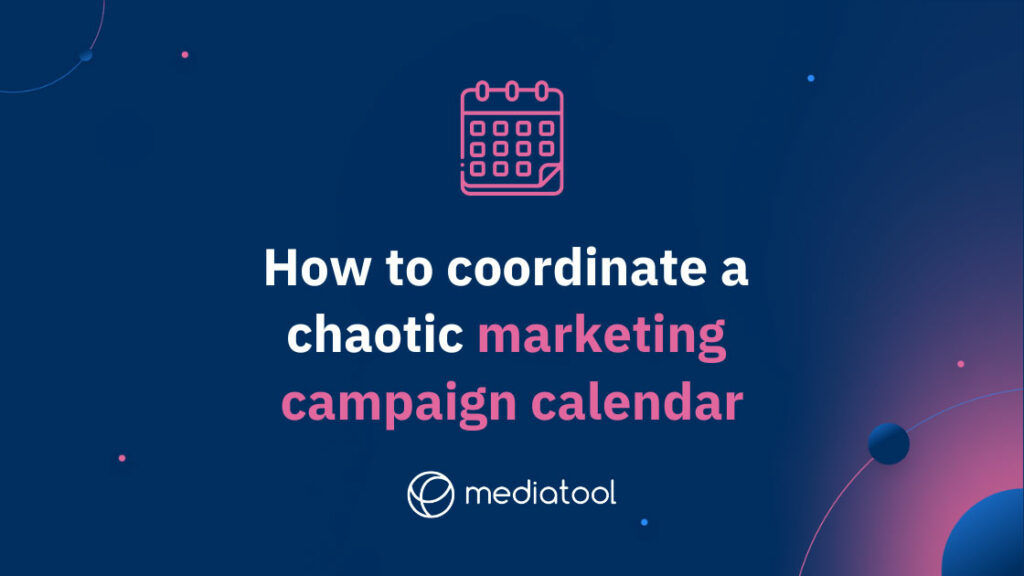Every marketing team and media agency knows the value of an organised calendar. A clean marketing calendar is one of those essential tools no high-performing professional can do without, whether managing a single campaign or a dozen clients at the same time.
So why are media planning calendars kept separate from marketing campaign management calendars? You shouldn’t be forced to bounce between systems, manually updating the different calendars every time you change material due dates or push back a launch date.
While project management tools can help to keep things organised, setting up each campaign still demands your time to manually input details and due dates. Here at Mediatool, we’re helping to bring marketing calendars and media planning together for a more productive workflow.
What an efficient media planning calendar looks like
1. Automatically updated
Did your LinkedIn post become an SEO blog during the last media planning meeting? Or maybe the boss found more budget for Google Ads? This is the kind of information you want to adjust once, and know the change is applied universally across every campaign planning touchpoint.
2. Intuitive
When you make those changes, what happens to the UTM code you were going to use for data tracking? These adjustments seem simple, but it takes time to manually update all the details you will need later.
A useful marketing calendar will recognise the changing shape of media data. When a post becomes a blog, for example, impressions might be replaced by page views in results data.
3. Accessible
One of the most pervasive problems with individual calendars is shareability. People often keep private appointments in email calendars, so sharing those is off the table. Team calendars work internally, in a limited capacity, but inviting an external client or agency partner is either impossible or an IT security nightmare.
And keeping a calendar on a shared spreadsheet? That hasn’t been a smart solution since 1997.
Media planning calendars need to be viewable by the entire team, including outside partners, without opening the business up to security risks.
4. Layered
Marketing calendars can quickly become chaotic. Those little coloured bars seem to dance and merge, to the point where the calendar is bordering on nonsense. A better media planning calendar can be condensed to only show high-level information, and selectively expanded to find relevant details fast.
5. Uniform (and universally appealing)
Personalised media planning calendars are only manageable until a team grows big enough to share documents. At this time, information will inevitably be misinterpreted or deadlines missed. Marketing calendars, like document templates and insertion orders, should follow the same structure for each campaign.
Of course, there needs to be some room for personal preference.
6. Flexible
The ability to change select parameters (view settings, expanding/collapsing information, display order and grain and grouping, just to name a few) within organisation-wide rules enables people to get the information they want.
Flexibility in media planning calendars saves time and avoids arguments about which information hierarchy is best. You can trust us on that.
How Mediatool built the ultimate marketing calendar
As marketers ourselves, we know the value of a dynamic and intuitive calendar (and the frustrations of sub-par calendars). In the Media Plan section of Mediatool, users can find a calendar that instantly pulls in media data from Sheet View.
The result is a clean and flexible online marketing calendar built to be robust and secure.
How does it work?
Here’s an example for you: The FMCG Company has a 3-month holiday campaign coming up. The marketing team finished entering media data into the Sheet View, and now the team’s calendar looks like this:
We can clearly see something is happening each week. But what are we up to this week? Let’s expand the view:
Great, so now we know we have assets running across multiple media platforms. In the last marketing meeting, the CMO asked for an update on the TV spots we have in market this week. Easy:
We can quickly expand our view and click the activity to see all the relevant details. Here’s how that process looks in real-time:
Let’s look at it a different way
This is just one example of the view settings. You might prefer to:
- Focus on the week or month ahead by changing the timeline preference
- Show activity on a monthly grain, rather than weekly
- Add a measurement column to show expected results at a glance
- Turn measurement figures on and off in the calendar
You can also change the fundamental view, for example, by grouping information by brand, product, city, event, market, or any other hierarchy you choose.
When it comes to managing a complex campaign, this flexibility within defined organisational parameters allows team members to do their different jobs more efficiently. Media planners can add media data quickly and manage the calendar from a global position. At the same time, a social media manager in a different country can rearrange their calendar to show the most relevant data.
Custom user access prevents certain users or groups from making global changes while giving them the flexibility to rearrange the way their calendar looks within their profile.
Even two people sitting beside each other can have completely different calendar views. But the same data populates both calendars, so there is no confusion or double-handling.
It all comes back to productivity
Mediatool is the all-in-one productivity platform for marketers and media planners. While we could talk about the calendar for a lot longer, and in more detail, there are other functions and features feeding into and out of the calendar that make your job easier.
Interested to learn what they are? Book a free Mediatool demo to get hands-on with the best media planning calendar in the business and see what else Mediatool can do to streamline the way you work.





